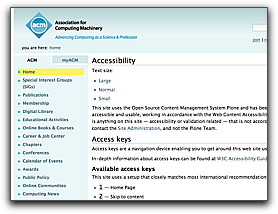Accessibility
![]() You're a professional musician.
You're a professional musician.
One night, you happen to be in the area of the door at one of your gigs and notice that there is a large gentleman standing in the doorway turning people away. You edge closer to hear what he's saying.
"Sorry, you can't come in, you're blind. The band don't want blind people at their gigs or buying their CDs!"
You are horrified!
"Hi, you're shortsighted, aren't you? Right, you can come in but you'll have to stand at the very back and won't be able to see much. Band don't really want shortsighted people being able to see them!"
You are outraged!
Then you see that he is holding up a printed card and asking people to read it.
"Sorry, the fact that you can't read this means you're colour-blind. Can't let you in I'm afraid. Band don't want colour-blind people coming to their gigs!"
By now you are absolutely incandescent!
You find the promoter and vent your wrath, angrily asking who this idiot is and what he's playing at. The promoter replies, "Nothing to do with us - he told us he was part of your team, that he does this at all your gigs!"
Who is he?
In a large number of cases, he's the person who built your website!
And the statements made above are exactly the message around 60% of all musician-related websites are giving to those people described.
Quoted from Dick Gaughan's GaelWeb site.
A contextual definition of accessibility
"The goal of accessible web design is to maximize the percentage of potential audience members who are able to use the service. By that reasoning, any change which increases the percentage is a step towards accessibility, and conversely, any change which decreases the percentage is a step away."
—Kynn Bartlett, Idyll Mountain Internet
Progressive Enhancement and the Future of Web Design
"Progressive enhancement is an approach to web design that builds documents for the least capable devices first, then moves on to enhance those documents with separate logic for presentation, in ways that do not place an undue burden on baseline devices but which allow a richer experience for those users with modern graphical browser software. It uses one markup document and a variety of different style sheets to provide a progressive, gradually enhanced experience across a wide variety of browsers."
—Steven Champeon, Progressive Enhancement and the Future of Web DesignProgressive enhancement ensures maximum access regardless of user agent. To achieve this, start with well-structured HTML and then add additional technologies. Accessibility is unlike to be achieved by designing for a specific browser or device. Keep in mind web standards and graceful degradation (avoiding filters and hacks). Instead, start with something that is accessible to everyone.
An example of a web site accessibility statement
 The power of the Web is in its universality. Access by everyone regardless of disability is an essential aspect.
The power of the Web is in its universality. Access by everyone regardless of disability is an essential aspect.
